|
|
| Sammio Builds and discussions Sammio bodied car builds and specials |

2nd April 2015, 22:46
|
|
Senior Member
|
|
Join Date: Jan 2015
Posts: 168
|
|
 I am worried a bit sometimes......
I am worried a bit sometimes......
I am reading myself into several builds of Sammio,Miglia and A352 Tribute's using a Triumph base car.
Usually the chassis of the donor is not as good as it should be so a lot of repairs are done.As the bulk of people who are doing this are just hobby mechanics for the most they are doing a great job..........until it comes to welding!
As we all are on a tight budget the welding must be cheap,so a budget hobby machine is bought and they start welding........they think!
As i have looked at many buildpictures of chassis welding sometimes the hairs in my neck stand up..........splatter,splatter and the repair plate is done,the angry grinder smooths out the rest,job done.
No penetration,no gaps filled and sometimes whole area's where the weld is off the seem that has to be welded,seam sealer over it and it will pass inspection.
My biggest concern are the comments after the builder/welder has put the pictures on,comments like "looking good,nice work,awsome job"are more common as"do you think your welds are strong enough?or you better leave this to a craftsman"............this way the builder/welder has the idea he's done a great job while he's not.
I am 57 years old and welding almost 40 years,the last 25 years i've been following welding classes every 2 years to keep my certificats and permits and i am still learning.
It is not my intention to put enybody down,only be aware if you are welding to do it right or do it not.
I am sure there will be comments as"All my welds still stick together and are very strong"...........are they?
My advice will be to buy a decent welding machine,use clean metal and follow a basic welding class,money well spend.
Remember YOU welded it but YOU also drives it around..........as these cars are not the safest cars on the planet(a plastic tub bolted or glued to a flimsy frame on a 40 year old chassis)and seatbelts mounted on a 3mm plate which is "welded"to a thin piece of tubing...............well you catch my drift.
Be safe....(as possible)
René

|

3rd April 2015, 07:31
|
 |
Senior Member
|
|
Join Date: Feb 2012
Location: Wembley, London
Posts: 5,056
|
|

Rene - You are certainly making a very valid point about the quality of amateur welding.
Personally, I know my first attempts at welding are not as good as my current attempts as welding.
I also know that my current attempts at welding are still a long way behind a professional welder.
So I have always been grateful when people point out any errors I make on my own build.
Quite by chance, I have actually been thinking about this myself recently for two reasons:
- A welding quality thread started over on Rods 'n' Sods.
- A link someone else posted to some photos of this crash as Goodwood.


Which also ties in with another valid point made:
"...these cars are not the safest cars on the planet(a plastic tub bolted or glued to a flimsy frame on a 40 year old chassis)..."
Especially as the Lister-Jaguar (#8) has a "proper" roll bar & I don't even have an "amateur" one.
Whilst I am not actively trying to build a "death trap", I am fully aware that this is not a modern/safe car.
So I intend to treat driving this car the same way I rode/raced motorcycles over almost 20 years, with respect.
Similarly, I rode my bike differently with a passenger on board, compared to solo riding in terms of my risk perception.
I want to take my wife and children out in my car and will not be doing this without a suitable degree of caution.
I also would not sell the car without ensuring any potential buyer had read my build thread.
That way, they can make their own mind up about the quality of what I have ended up with.
Overall, I think it is a good idea for amateur builders to share their builds on here and get help/assistance from professionals.
It is also great when people who do work to a professional standard show us how they do things too. 
I know I am trying to be as safe as possible, cheers, Paul. 

|

3rd April 2015, 07:47
|
 |
Senior Member
|
|
Join Date: Jul 2011
Posts: 5,328
|
|
 YeeeHaaa!
YeeeHaaa!
I am a cowboy welder...
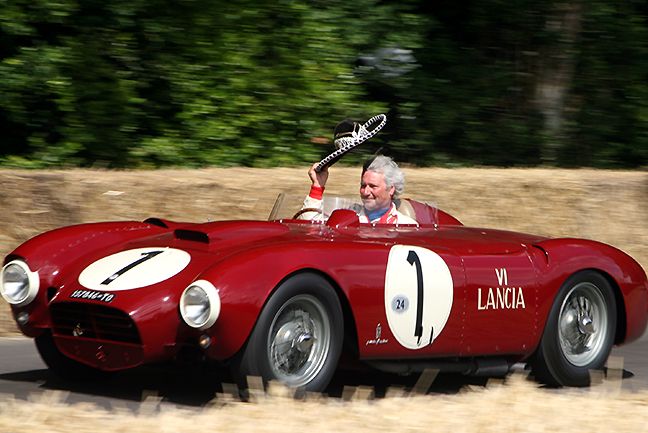
...and I'll tip my Stetson, well, sombrero (does that make me a goucho welder? or if I had a moustache a Groucho welder?) to the other amateurs who've ignored professional welder's advice to pay them a sack of cash to do the job instead.
I know that all the 'looks good' comments about the welds I achieved with my £60 from Amazon MMA stick welder (there it is on the floor while I made my fuel tank mounts!!!) -

...were mostly people just being polite, and I know I should have bought a more expensive rig and taken a proper college course first, but I do take issue with the assertion that the job I did isn't safe.
My first point is that my donor was sold to me as being 'practically MOT ready and it did look good -
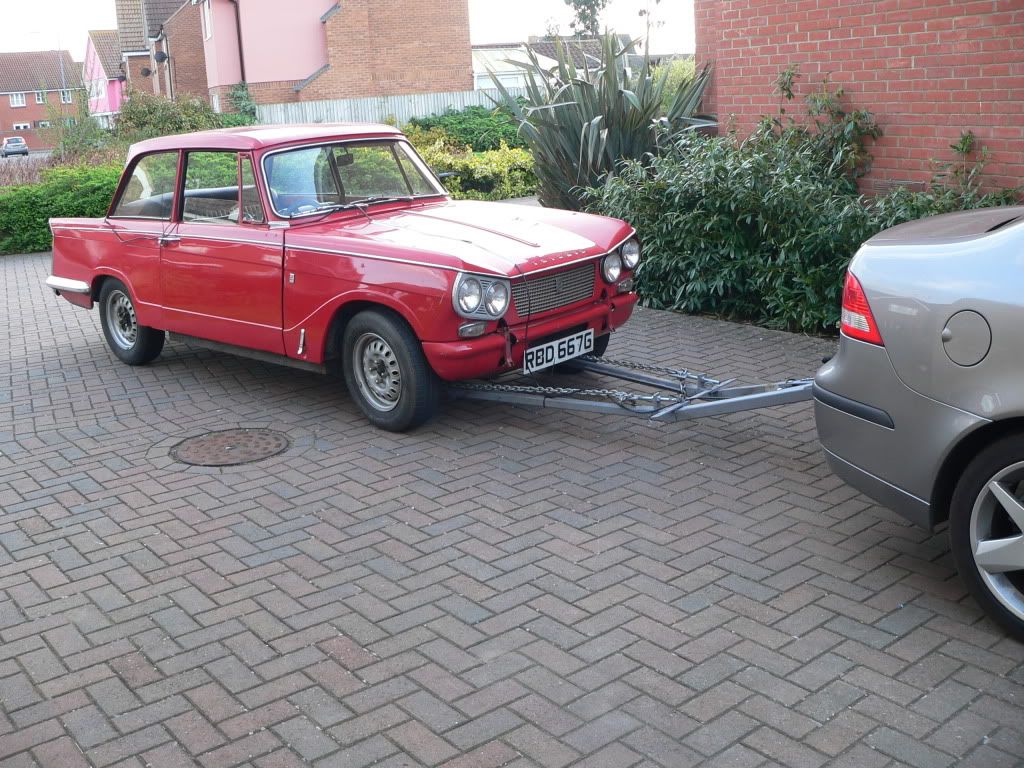
The ad indicated that it had benefited from 'extensive professional chassis restoration', and on removing the body I found that there were beautiful, smoothly looped welds on most of the outriggers, both side rails and in places on the main rails. Nice.
Then I gave them a poke with a screwdriver to 'prove' them for myself, which is when I found that the beautiful welds had been used to disguise this -
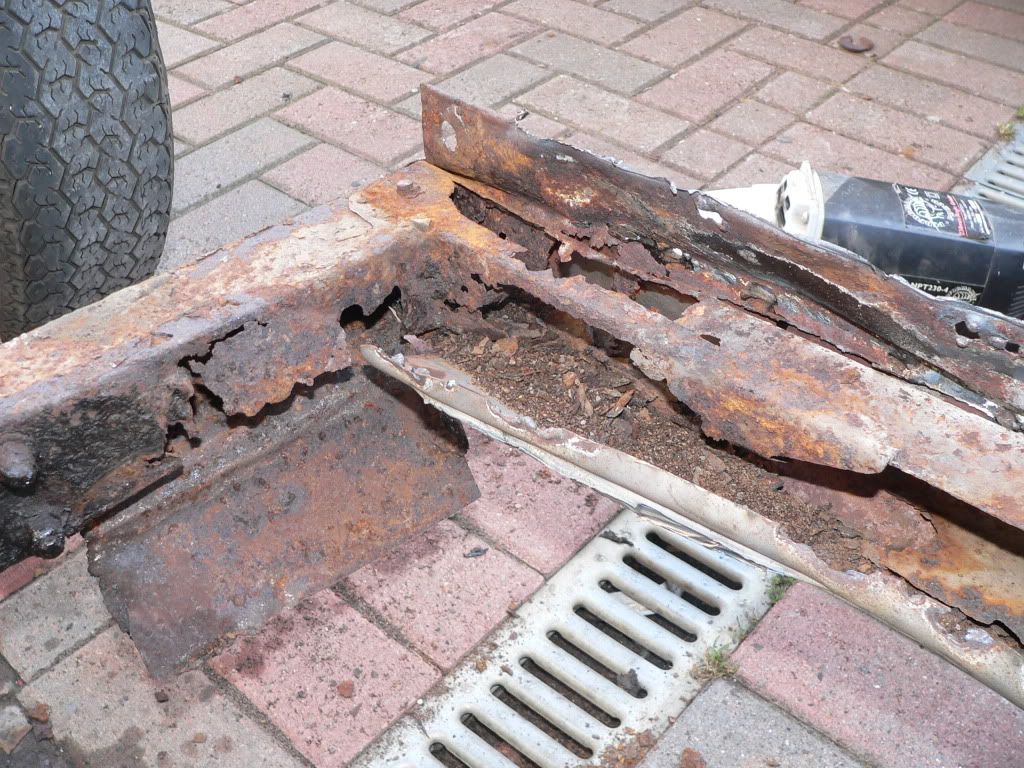
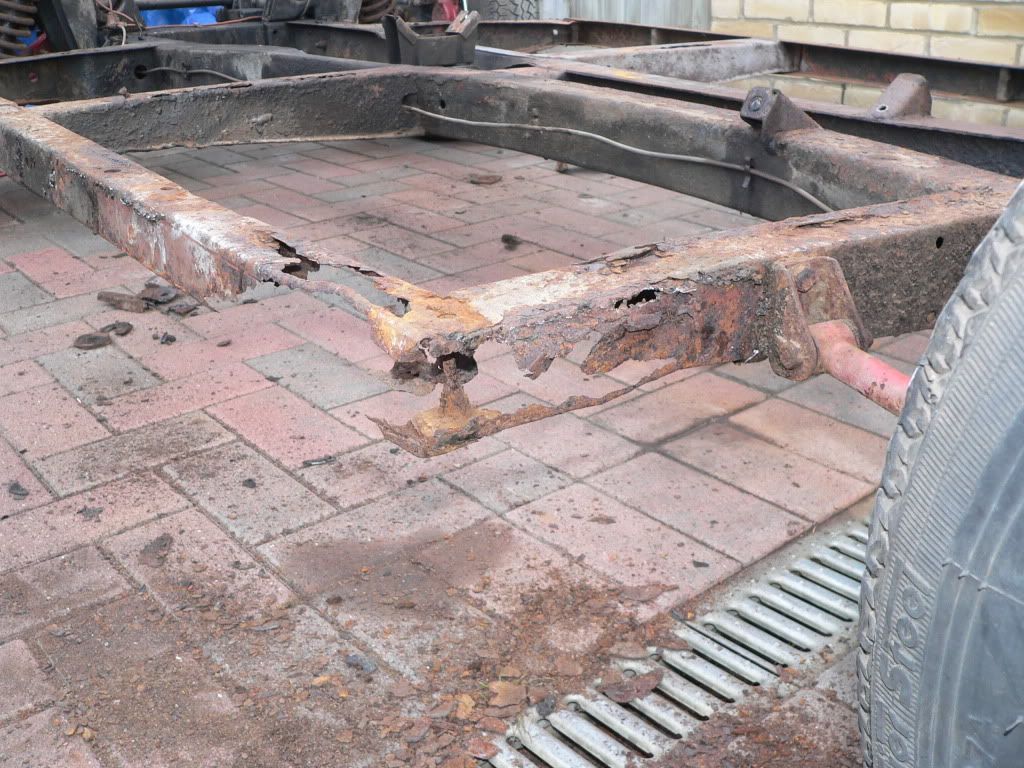
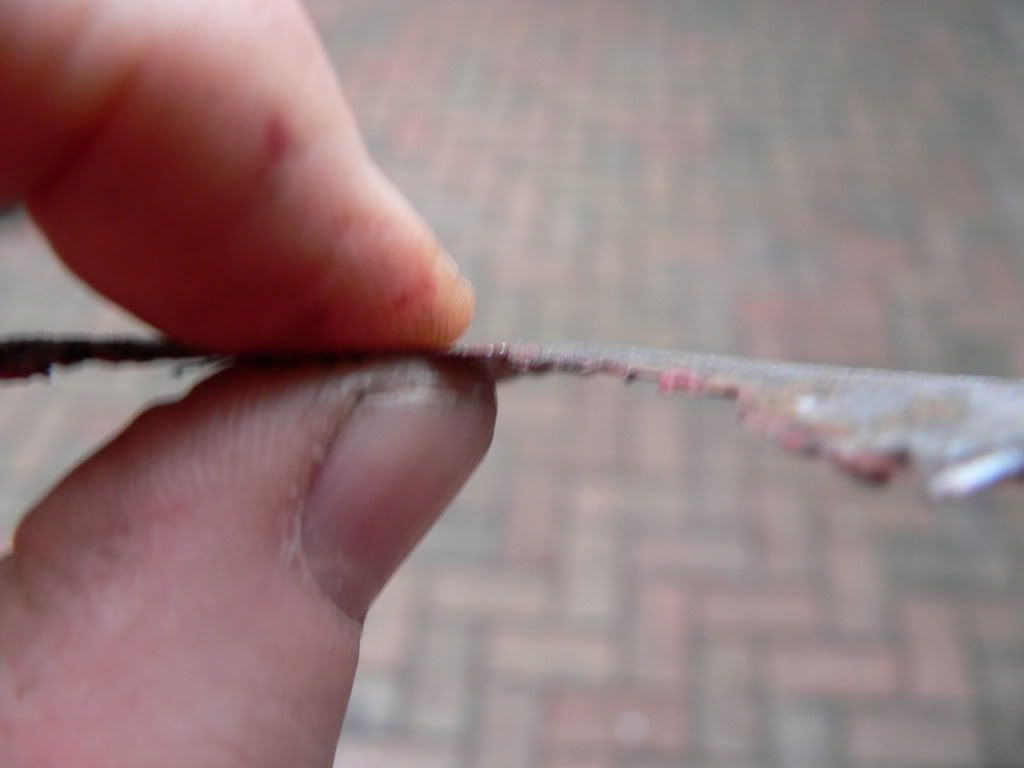
...paper thin sheet steel expertly welded over the ferrous oxide and fresh air that was holding the chassis together. In fact, all that had been holding the chassis together was the fact that it was bolted to the body.
So I taught myself to weld and made sure that I only welded sound metal to sound metal, using new parts where available -
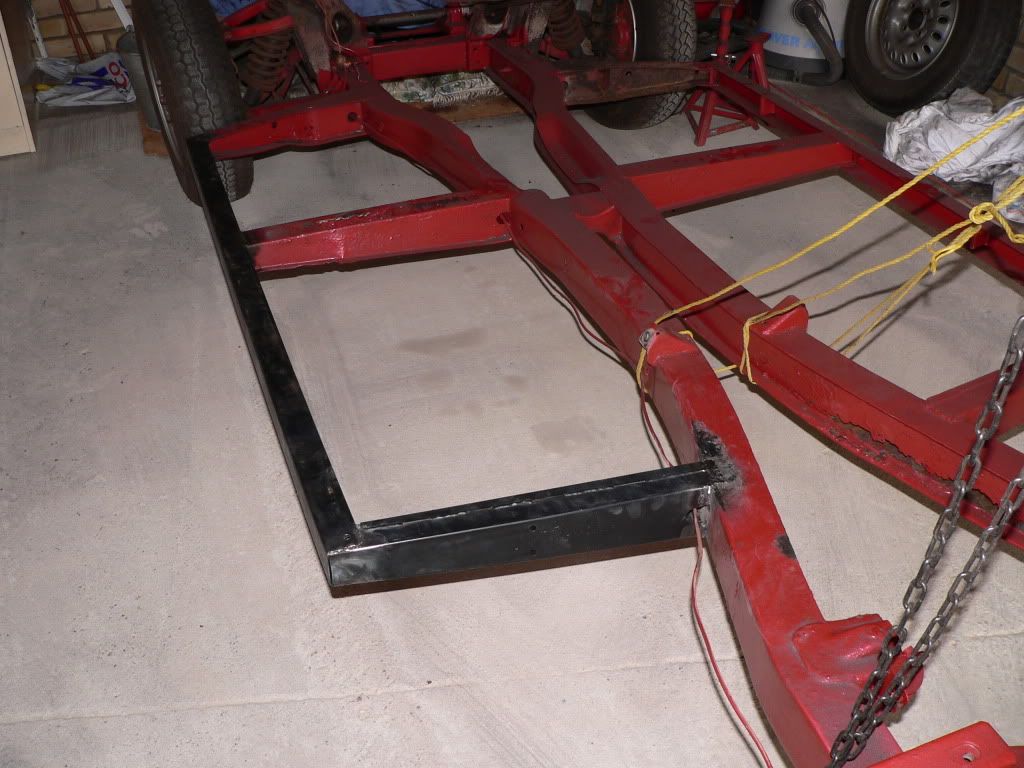
I also made sure anything structural was strong enough for me to stand on without failure, and I'm no ballerina. Overall I'm 100% satisfied that my ugly, spattered welds are strong enough to do whatever job they needed to do on my chassis and frame.
Do I have any actual evidence for this claim? Well, yes actually. The welds that are subject to the most strain, which are under tension even when the car is parked up and not being used, are the mounts I fabricated to raise the parking brake cable guides (to compensate for the altered rear wheel camber) -
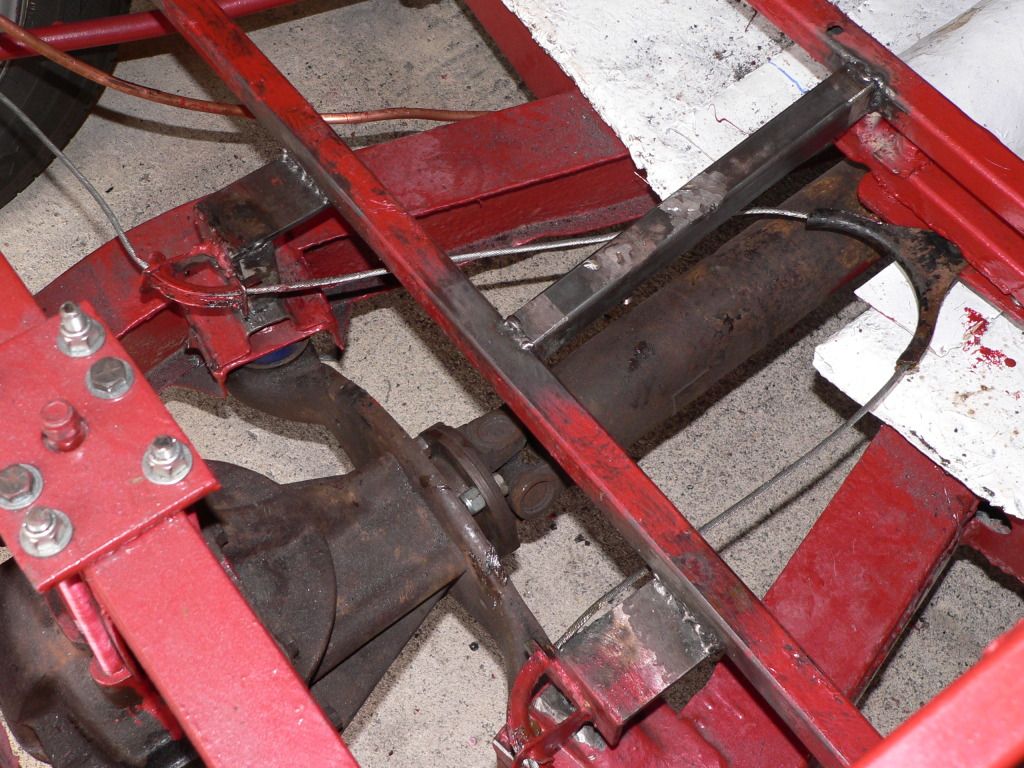
They've now been under a lot of stress for two years and have been tested to the extreme - they've twice had an MOT tester pull the handbrake on so hard it locked the rear tyres up at 30mph, and I jacked the back of the car up without releasing the handbrake first (bad idea) which resulted in the (brand new) handbrake cable snapping, but my welding held fast.
And as for the risk of driving one of these, there's a level of risk in everything. Over the next few months I'll be driving my home built Spyder on backroads and motorways and sure, it's not going to be as safe in a crash as a modern car, but in August I'll also be climbing aboard one of these with my family -

Can you guess which mode of transport I'm more worried about?

|

3rd April 2015, 09:24
|
|
Senior Member
|
|
Join Date: Dec 2013
Location: Sunny Cumbria
Posts: 470
|
|

Quote:
Originally Posted by reneanglia

Usually the chassis of the donor is not as good as it should be so a lot of repairs are done.As the bulk of people who are doing this are just hobby mechanics for the most they are doing a great job..........until it comes to welding!
René
|
René, I agree with that statement and not just the builders but the kit manufacturers should up their game, I have noticed in close up photographs that the welds and joint design employed in some kits leaves a LOT to be desired, weaving welds, obvious lack of penetration and poor joint design even in critical areas like seat belt mountings and roll bar mounts.
It just needs a major fatal accident which can be laid at the door of bad 'kit car' welding to up the anti with the likes of VOSA. Quite apart from the obvious distress for those involved.
Having read the VOSA IVA guidance notes for the IVA Test regarding welds, they remark that untidy welds are not always the strongest.
There are really two aspects of welding which affect us, structural welds and cosmetic welds. The cosmetic are usually the most difficult, on thiner steel and frequently more rusty panels. In my opinion that is usually less critical although I have to say I have cringed at some of the earlier attempts of totally inexperienced car builders.
The structural as in chassis, load bearing brackets and members supporting seat belt mounts and 'A' and 'B' post supports, are obviously more critical and the safety of the car depends on them.
With the usually heavier structural welds it's usually easier to get sound welds except perhaps with the tiny 'hobby' MIG welders which lack the power to penetrate the heavier metal.
I am 67 now, I bought my first Oxford 110 Amp oil cooled welder when I was 16. A friend who had just done a tech college course showed me the basics and I embarked on my gradual learning curve of sticking bits of metal together. I graduated to Oxy - Acetylene having been taught by a local transport company mechanic foreman, obtained my own cylinders and gaind more experience. Then MIG came along, I was fortunate in that my welding supplier rep was an Ex BOC technical trainer with a vast experience in the engineering world. He taught me to MIG weld, Then to TIG, stainless and aluminium. Most of my welding has been connected with the construction industry, digger buckets, structural girder frameworks staircases etc. Kitchen stainless, etc.
For all my experience I have no qualifications although I have been invited to weld for people who respect my skills. Despite this I am aware of the pitfalls of welds, I do my own quality assurance on critical welds, usually with a large hammer!
One tip I would offer the aspiring welder is to watch the weld cool... As the weld cools from white to red to black, you can get a good clue if it's actually a weld or merely decoration to cover a joint. The cooling should be even across the weld, NOT one sided, which indicates the weld hasn't penetrated both sides of the weld evenly. The two pieces of metal being welded should also get visibly hot, if one is red and the other not, beware!
There are so many aspects to welding, so many methods, so many techniques and every weld is different. Techniques used in manufacture don't fit in restoration or repair. You have spot welding and plug welding, MIG, TIG and stick, maybe even gas?
I noted with concern that the guy who promised to show Paul how to use his loan welder proved hard to get. That left Paul struggling. I am sure this is often the case when the new welder get's his first MIG set and tries to make sense of it. There is no substitute for somebody to demonstrate the techniques then allow the newbi to try his hand with someone to correct the technique. I have taught quite a few friends and apprentices their first experience of welding, my son Michael has already tried his hand. My (Ex) wife put down some lovely welds on an MG I restored and she really enjoyed the experience.
I think I am rambling now but perhaps you get my drift, you need experience and some guidance, if only at a distance. Preparation and technique are vital ingredients, together with appropriate equipment.
Last edited by 8 Valve Ed; 3rd April 2015 at 10:00..
Reason: Bloody auto-correct, again!
|

3rd April 2015, 09:31
|
 |
Senior Member
|
|
Join Date: Feb 2012
Location: Wembley, London
Posts: 5,056
|
|
I do accept Rene's point about the quality about amateur welding and think it is a good thing to raise it.
But this quote reminded me of something else...
Quote:
Originally Posted by Mister Towed

...paper thin sheet steel expertly welded over the ferrous oxide and fresh air that was holding the chassis together...
|
One thing I can say is that I am not aware of any builders on here actively hiding / covering up a rusty chassis.
So at least everyone is attempting to repair their cars properly.
Cheers, Paul.  |

3rd April 2015, 09:36
|
 |
Senior Member
|
|
Join Date: Feb 2012
Location: Wembley, London
Posts: 5,056
|
|
8 Valve Ed - Sorry your post appeared while I was previewing mine. 
But more good points and thanks for sharing.
Last edited by Paul L; 4th April 2015 at 06:20..
Reason: Typo
|

3rd April 2015, 09:38
|
|
Senior Member
|
|
Join Date: Dec 2013
Location: Sunny Cumbria
Posts: 470
|
|
I tried to add this further paragraph to the last post, twice... But it didn't appear in the post???
It was: I have read in the IVA guidance notes from VOSA, that untidy welds are not usually the strongest.
While I typed the edit at the end of my post, it was inserted after the second paragraph??? COMPUTERS!!! LOL
Last edited by 8 Valve Ed; 3rd April 2015 at 10:18..
|

3rd April 2015, 10:36
|
|
Senior Member
|
|
Join Date: Apr 2014
Location: Midlands
Posts: 405
|
|
I am more than happy for someone to come round and give me some tips as i was a teenager the last time i welded but at least i know what it should be. Plus non ofbmy are structural. I'm in the midlands if anyone is offering ☺
|

3rd April 2015, 11:30
|
|
Senior Member
|
|
Join Date: Jan 2015
Posts: 168
|
|

Thanks for the replies,just what i was hoping for.
Welding is more difficult as most people think,without proper education you cannot judge the welds you have put down,even if the look good in your opninion they could be falty.
Always weld a testpiece first to dial in the welder.
If you gonna make structural welds make a testpiece and test the weld by destroying it,cut it in half with a thin disc grinder,sand it smooth and take a look if there a no air pockets,debri or cracks showing.
Don't grind on structural welds as you make the weld less strong.
I am very sorry my knowledge of the English language is limited,i am not able to write down all tips and tricks i know,i'll think another pro-welder or simular has to do that.
I know for some paperpushers like Paul L.(sorry Paul)it is almost impossible to do good welding,especially when welding outside(wind blowing protection gas away)but it is possible to make resonable welding with a hobbywelder.
At work i usually weld with megabucks costing machines,but in my shed i am welding with an old 160amp mig............the welds i lay down with this old banger are solid and strong enough.
Happy welding all........

|

3rd April 2015, 12:32
|
|
Senior Member
|
|
Join Date: May 2013
Posts: 2,161
|
|
Hey Rene, I cannot speak for others, but to ease your worries in my particular case, years ago when I used to sky-dive and para-glide, I was a parachute rigger, (which helped me make my leather seats)
And I also designed and made my own harnesses, and it does not get any better than diving out of a plane from 4000 metres high, and trusting your life to your stitching.
My welding is the same, and I've never had a stitch or weld come adrift.
You must give some credit to the guys doing their best, and I'm sure they get their welding checked out by someone if they are not sure.
Hope this re-assures you in the welding area!
Scottie
|

3rd April 2015, 16:29
|
 |
Senior Member
|
|
Join Date: May 2011
Location: Somerset
Posts: 1,671
|
|

I fully admit that I taught myself to weld and that I'm still learning things every time I do it. But I did a lot of research, reading, watching videos and talking to professional welders (3 of my family included) before I even considered buying my MIG welder.
One tip I was given that I found invaluable was, after you get yourself the best welder you can afford, then get yourself a bulk load of old steel (e-bay! or scrap from a local engineering firm) and practice welding together different thicknesses and different shapes at different settings.
Then when you've welded them together, cut them apart to see penetration.
Only once you have a wheelbarrow full of bits of metal you've welded together, hit with hammers and cut apart again will you even start to get an idea of how your welder works in different situations and at different settings and with _you_ doing it!
I'm not arrogant enough to say that this way of learning will suit everyone, but I know I learn best from 'doing' and I've also thoroughly enjoyed myself along the way 

|

3rd April 2015, 20:05
|
|
Senior Member
|
|
Join Date: Dec 2013
Location: Sunny Cumbria
Posts: 470
|
|

A couple of things which I have been taught and the technique I employ.
Firstly for MIG and stick welding I always use my left hand, (I am right handed) to hold the welding torch (or rod) as near the tip as I can, bearing in mind it can get hot. This steadies the welding torch and helps produce a more controlled weld. I use a stout welding glove on my left hand but no glove on my right hand to give me more feel and control while holding the torch. With stick welding I run the welding cable over my right arm and sometimes over my shoulder to take the weight off my wrist and to allow better control of the torch. I also insert the rod into the straight out position and bend the rod to the desired angle for the optimum for the weld in hand.
Another thing which is fundamental is that when MIG welding you increase penetration by 'pushing' the torch and decrease penetration by 'pulling' the torch Obviously you want to increase penetration on thicker metal and reduce it with thin metal. This is in addition to the dial settings on the welder of course.
If you are stick welding (or TIG) with a DC set the balance of heat between the + positive and the - negative outlets of the welder are + = 66% - = 33% so if you want strong penetration you make the job + positive if you want to reduce penetration for welding vertical or overhead for example you make the job - negative. With AC the balance is 50/50 so no advantage is gained by swapping polarity.
Hope this bit of info helps somebody. 
Last edited by 8 Valve Ed; 4th April 2015 at 07:21..
Reason: Adding a little text for clarity.
|

4th April 2015, 06:25
|
 |
Senior Member
|
|
Join Date: Jul 2011
Posts: 5,328
|
|
The advice regarding steadying the mma rod with your spare hand will definitely help me next time - that was one of the frustrations I found with using it, the tip waggling around and striking an arc on random bits of chassis it happened to get near. I might just adapt that method by using a wooden clothes peg to insulate my fingers from the searing heat though... Cheers.  |

4th April 2015, 08:13
|
|
Senior Member
|
|
Join Date: Dec 2013
Location: Sunny Cumbria
Posts: 470
|
|

Mr T, glad it's helped, I use a standard heavy leather welding glove, a pair costs about a fiver. Surprisingly for the time the average weld takes the heat inside the glove isn't that great. I grasp the rod quite hard and scratch it on the job to initiate the weld, then position it at the start of the weld. I very rarely weld without holding the rod firmly for control.
It isn't just the tracking of the weld but also the ark length which is important, some rods are happy to be rested on the surface and burn up inside to make the weld. More usually I weave the weld slightly, sometimes tilting it to one side or the other to ensure the ark is melting both sides of the job. Usually a short ark is best because it ensures the globs of molten metal transfer from the rod to the weld without being exposed to oxygen.
Another thing, mostly I throw a part used rod away, I won't start another weld with a half used rod. The heat in the rod seems to alter the flux and welds made with part used rods don't seem as good, might be my imagination but that's what I do.
For vertical welds for strength I weld upwards, for appearance I weld downwards. Welding upwards I point the rod upwards almost vertically and weave sideways which leaves a rough waving weld but it is usually a strong weld. To weld downwards I keep the rod horizontal don't weave much and set the power much lower, moving quite fast to keep ahead of the weld pool, this can produce a nice weld but it lacks the penetration of the vertical up weld.
I think the Rods 'n' Sods thread Paul mentioned is this one which has some interest.
http://www.rodsnsods.co.uk/forum/topic/welding-326450
Clearly without pictures it's difficult to show some of these techniques. Photographing welding isn't the easiest... I will give that some thought.

|

4th April 2015, 19:28
|
 |
Senior Member
|
|
Join Date: Feb 2012
Location: Wembley, London
Posts: 5,056
|
|
Here is a post that SeaNick kindly prepared and posted on my build thread...
Quote:
Originally Posted by seanick

...When it comes to your frame I would use an ARc welder as the box has plenty of thickness, and you can weld in a gale of wind-well nearly.
I took some pics of a join I did this afternoon on 1" box section.
A bevel on the ends at 30deg, nearly through to the other side, and the millscale removed from the other piece...

Then line them up....

Run a weld in the groove, leaving the black slag behind....

Remove the slag and do the other edges.....

The great thing is if you gring out the joint first and lay a reasonable weld in there there is no grinding afterwards, as the weld finishes flush.
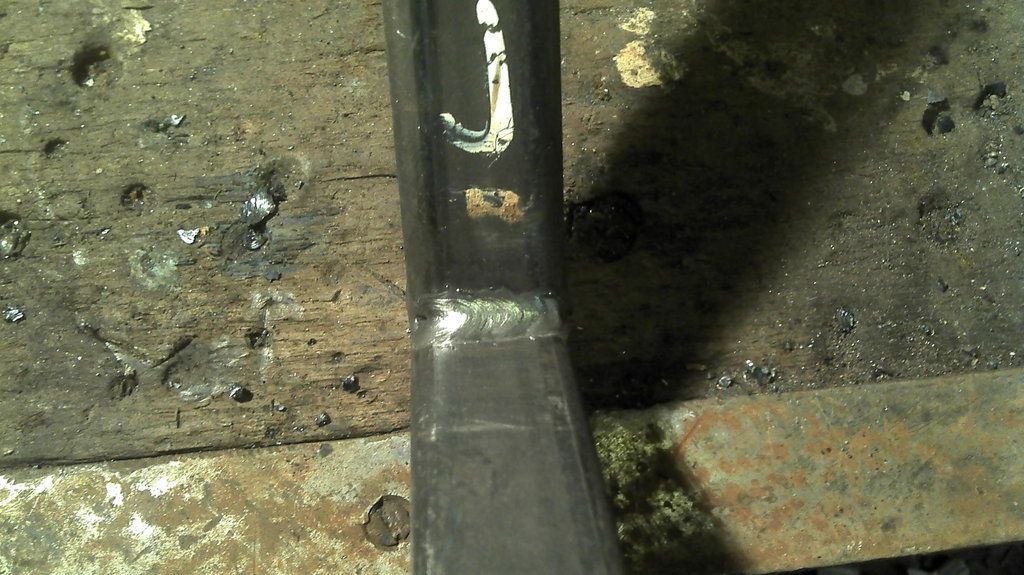
However I still left a hole! More practice required!!

Hope this helps a bit, N |
|

4th April 2015, 20:37
|
|
Senior Member
|
|
Join Date: Dec 2013
Location: Sunny Cumbria
Posts: 470
|
|

Quote: "However I still left a hole! More practice required!!"
Called 'Crater filling' common problem, you need to linger at the end of the weld for a little and gradually remove the rod. Usually more of a problem with TIG, esp. on aluminium.
There is a lot to be said for stick welding, especially on box section, it gets the job done with little fuss and much cheaper than MIG. I have my DC welder sat on top of the MIG and only have to swap the cables over.
One thing which I haven't seen mentioned here is gasless MIG welding. Since the difficulty in obtaining Argoshield I haven't been able to swap my cylinders as I used to. I ran out one day in the middle of pre-MOT welding, unable to get hold of Argoshield, I bought 5Kg roll of flux cored 0.8mm wire. Assured it was OK for bodywork but very sceptical and I was pretty desperate to get the car prepared for it's MOT I bit the bullet and went for it. At first it was a disaster, rubbish welds, horrible splatter everywhere and no penetration to speak of.
I couldn't believe that it was as it should be, so I did some research and discovered I needed to reverse the polarity, from negative job, positive torch for gas, to positive job and negative torch for flux cored gasless wire. Anyway, I had to delve into the welder to change the polarity, once switched it was brilliant. A bit smoky and the slag is difficult to get off without grinding the weld but it worked. The welds seemed if anything easier on very thin, (read paper thin, very rusty) metal. I filled holes the size of a 50 Pence coin with ease, just by building up the weld and running a bead around the edged until the hole was filled, with a little flap disk grinding it was indistinguishable from the original bodywork.
So, once I got used to gasless MIG I was very happy. Recently a buddy gave me a couple of cylinders of Argoshield, but unfortunately they have now run out, so I will be back to gasless again soon. It isn't quite as nice as the normal gas MIG, the welds aren't as clean and nice but they buff up well enough and with care they can be presentable. I usually buff my automotive welds up anyway.
If anybody is stuck for gas then it's a viable alternative. The wire is a bit dearer, about £50/5Kg but it goes pretty far and with the cost of cylinders and the gas it's probably cheaper by far, depending on your circumstances (some people can 'get hold of' gas when they need it). The flux cored means you are not affected by the wind either, that's a great plus when you have to work outside. I have welded some fairly thick metal with my 185 Amp machine, If I turn the wick up, it's capable of blowing through 10mm steel welds if you aren't careful.
I have found some pictures of gasless welding. It was a hole at the back of the chassis which had been drilled right at the edge of the flange and was in fact only about 2/3rd's of a hole. The hole was threaded M6, and used to secure the boot lid hinges.
I wasn't happy about the hole right at the edge of the flange so I thought I would try to build the flange out and provide more support for the hinge. The flange is 3mm steel. This was 'as welded'.

Ground up to shape, no further welding done.
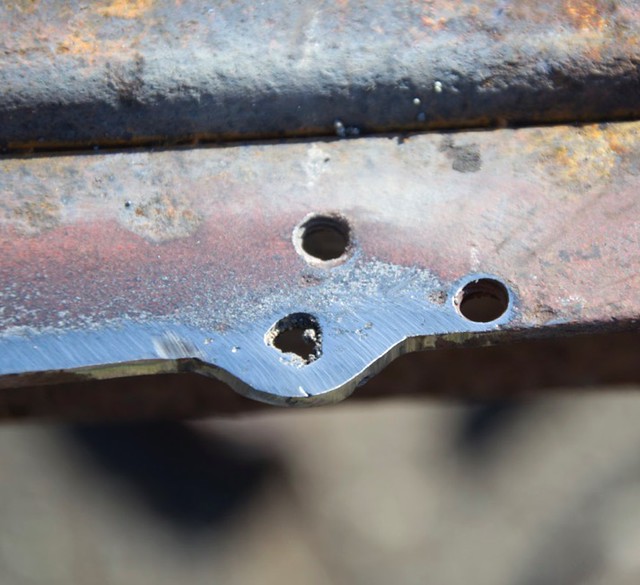
The hole re-tapped M6, a bolt fits and holds nicely.

I was quite proud of that little job. I could have tidied it up some but as it turns out I cut the whole flange off anyway!
Last edited by 8 Valve Ed; 4th April 2015 at 21:38..
Reason: Corrected my polarity, sorry for any confusion.
|

4th April 2015, 21:07
|
|
Senior Member
|
|
Join Date: Jun 2011
Location: birchington, kent
Posts: 1,769
|
|
8 Valve, I must check that polarity...
|

4th April 2015, 21:33
|
|
Senior Member
|
|
Join Date: Dec 2013
Location: Sunny Cumbria
Posts: 470
|
|
Have just been out to the garage, the welder is set up for gas at the moment, the torch is positive and the job is negative. So it would appear I am wrong with my post above. To avoid confusion I will correct it. Post above now corrected.
Last edited by 8 Valve Ed; 4th April 2015 at 21:40..
Reason: Confirming correction.
|
|
Currently Active Users Viewing This Thread: 1 (0 members and 1 guests)
|
|
|
 Posting Rules
Posting Rules
|
You may not post new threads
You may not post replies
You may not post attachments
You may not edit your posts
HTML code is Off
|
|
|
All times are GMT +0. The time now is 20:10.
|